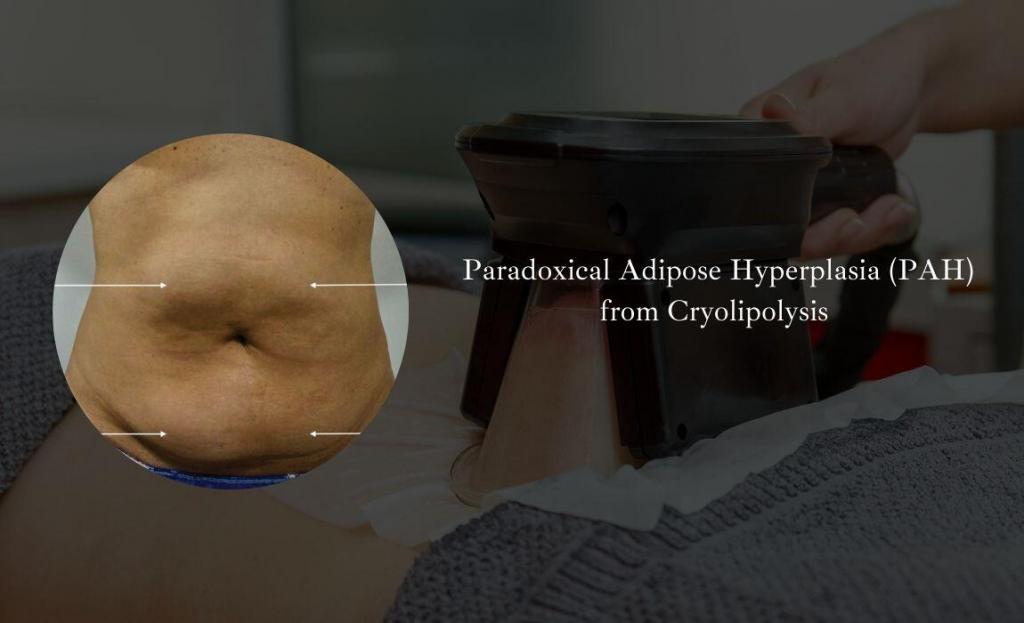What body contouring professionals must know about PAH after cryolipolysis

Supermodel Linda Evangelista brought a ‘little talked about’ side effect of cryolipolysis to public attention when she filed a $50 million lawsuit this year against Zeltiq (manufacturer of Coolsculpting). She said she suffered from paradoxical (abnormal) adipose (fat) hyperplasia (unusual increase in structure) or PAH. It’s important to note that PAH has been reported only with cryolipolysis technology. But as a body contouring professional, whether or not you offer cryolipolysis-based treatments, it’s critical to be well versed in the facts about PAH after cryolipolysis.
In this article, you will learn about PAH after cryolipolysis:
- What is Cryolipolysis
- What is paradoxical adipose hyperplasia (PAH)
- When does PAH occur
- How often does PAH occur
- How is PAH treated
- Steps to take if you offer cryolipolysis treatments
What is Cryolipolysis?
Cryolipolysis is a non-invasive technology that utilizes freezing temperatures to destroy fat cells, without causing harm to surrounding tissue. Specifically, the cold temperature triggers a programmed fat cell death, called apoptosis, and then the body flushes out the dead fat cells. The technology has been cleared by the FDA, and has been employed by various fat reduction devices dating as far back as 2010.
Besides the cryolipolysis devices with well-known names, such as Coolsculpting and Cryoskin, many, many other cryolipolysis machines are available for both professional and home use. These include machines manufactured in the US and abroad. And with these large numbers of units in practice, PAH after cryolipolysis is something we need to pay attention to.
What is Paradoxical Adipose Hyperplasia (PAH)?
Paradoxical adipose hyperplasia (PAH) is a known, but little-discussed side effect (or complication) that can happen following a cryolipolysis treatment. It is a process whereby fibrous fatty tissue grows rather than shrinking. In the case of Coolsculpting and other cryolipolysis devices delivering the technology via applicators, this fatty growth mimics a well-demarcated shape of the applicator. And due to the fibrous component of the fat associated with PAH, the PAH areas feel firmer than the surrounding areas.
Many theories exist about the cause of PAH after cryolipolysis, but as of now the cause is yet-to-be-determined.
When does PAH occur?
PAH after cryolipolysis is a delayed onset condition. The symptoms of developing PAH after cryolipolysis most frequently occur sometime between two and six months post treatment.
Signs that PAH may be developing include
- An uneven distribution of fat in the treatment area
- Visible deformities in the treatment area
- Exaggerated fat in the treatment area
- Multiple ‘hard knots’ in the treatment area
How often does PAH occur?
Most experts agree the incidence of PAH after cryolipolysis may be severely underreported.
Lending credibility to the belief that PAH after cryolipolysis is underestimated, conflicting data reveals very different numbers.
- A letter published in the Journal of Plastic and Reconstructive Surgery reported an incidence rate of 4 in 510, which is 0.78 percent
- A story from Science Daily estimates an incidence rate of 0.0025 percent
- A compilation of case reports from the Aesthetic Surgery Journal details the experiences of a Houston dermatology practice in which 4 out of 398 patients experienced PAH. That’s greater than 1 percent.
How is PAH treated?
PAH after cryolipolysis does not go away on its own. A PAH complication requires referral by non-invasive providers to a board-certified plastic surgeon who is familiar with the condition.
In most cases, power-assisted liposuction is recommended. But the client may need to wait for several months to have the procedure to allow the fat to soften.
PAH correction procedures may not always be successful. Supermodel Linda Evangelista is said to have undergone two procedures to correct her PAH complications, but both procedures proved unsuccessful.
Steps to take if you offer cryolipolysis treatments
Besides arming yourself with education about PAH following cryolipolysis, take these steps.
- Evaluate your clients for suitability for cryolipolysis
- For example, clients with poor skin tone (in the treated area) are generally not good candidates for cryolipolysis; radiofrequency and laser lipolysis technologiesare better technologies for these clients
- Screen your clients for pre-existing cryolipolysis contraindications
- As a reference, see your cryolipolysis device manufacturer’s recommendations
- Refer to your medical director, if applicable
- Train your providers about cryolipolysis
- Stay up to date on current training and the latest education
- Educate your clients about cryolipolysis (benefits and risks)
- Provide verbal education
Linda Evangelista alleges she was not warned about the possibility of PAH
-
- Obtain written informed consent
Include PAH in your Informed Consent Form
Conclusion
It’s important to know that PAH has not been associated with other fat reduction technologies, such as radiofrequency, ultrasound cavitation, vacuum, EMS, and laser lipolysis. Even so, clients may be apprehensive about any body contouring treatment now that PAH after cryolipolysis has come into the spotlight. Understanding this potential side effect (or complication) and possessing the capability of explaining it to your clients is essential for both their safety and comfort and your livelihood.
If you would like to learn more about non-invasive body contouring treatments, visit www.BodyContouringAcademy.com.
Want to expand your body contouring services menu?

Get body contouring certifications in the treatments of your choice
100% online, flexible and affordable
